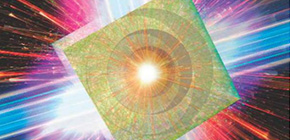
Could vacuum physics be revealed by laser-driven microbubble?
A “vacuum” is generally thought to be nothing but empty space. The ancient Buddhist sutra 色即是空, expressed in Japanese as shikisokuzeku and means “matter is void” or “all is vanity,” surprisingly explains well the essence of “vacuum physics” described by modern physics. But in fact, a vacuum is filled with "virtual particle-antiparticle pairs" of electrons and positrons that are continuously created and annihilated in unimaginably short time-scales.
The quest for a better understanding of vacuum physics will lead to the elucidation of fundamental questions in modern physics, which is integral in unravelling the mysteries of space exploration such as the Big Bang. However, to forcibly separate the virtual pairs using a laser’s electric field and cause them to appear not as virtual particles but real particles, the laser intensity required would be ten million times higher than what today’s laser technology is capable of. This field intensity is the so-called “Schwinger limit”, named a half century ago after the American Nobel laureate, Julian Schwinger.
Scientists at Osaka University discovered a novel mechanism which they refer to as microbubble implosion (MBI) in 2018. In MBI, super-high energy hydrogen ions (relativistic protons) are emitted at the moment when bubbles shrink to atomic size through the irradiation of hydrides with micron-sized spherical bubbles by ultraintense, ultrashort laser pulses.
In this study, the researchers confirmed that during MBI, an ultrahigh electrostatic field close to the Schwinger field could be achieved because micron-sized bubbles embedded in a solid hydride target implode to have nanometer-sized diameters upon ionization.
From the 3D simulations carried out at the Osaka University Institute of Laser Engineering, they also found that the density during the maximum compression of the bubble reaches several hundred thousand to one million times solid density. At this density, something no larger than a lump sugar would weigh a few hundred kilograms. The energy density at the bubble center was found to be about one million times higher than that at the sun. These astonishing numbers have been thought to be impossible to achieve on Earth. Their research results were published in Physics of Plasmas .

Fig.1 Envisioned picture showing all of the main events of microbubble implosion, i.e., laser illumination, hot electron spread, implosion, and proton flash at the end.

Fig.2
The article, “Relativistic proton emission from ultrahigh-energy-density nanosphere generated by microbubble implosion” was published in Physics of Plasmas at DOI: https://doi.org/10.1063/1.5093043 .
Related links
